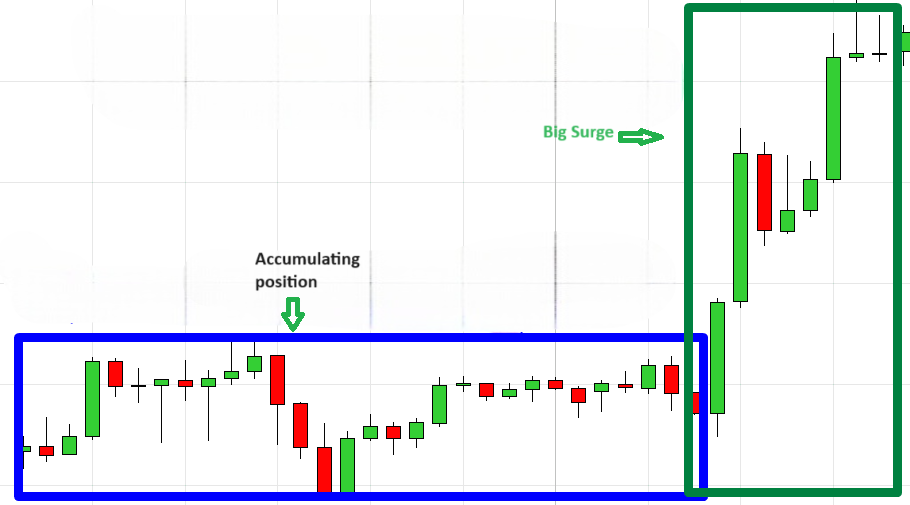How do big institutions accumulate stock, and why does the price move rapidly?
Once institutions establish substantial trading positions, they manipulate prices to generate profits. If they've accumulated a sizable Long position in a stock like ABC Ltd, they aim to drive the price upward into an uptrend
When it comes to executing trades, retail traders have two main weapons in their arsenal: market orders and limit orders. These may seem like basic building blocks, but knowing how and when to use them can make all the difference in your trading strategy.
Market Orders:
Market orders are like screaming “I want it now!” You rush into the market with no hesitation and take whatever price is available. This gets you into the trade quickly, but it also means you have little control - you eat up the orders in front of you no matter the cost.
Example: Imagine you want to Buy 20 Lots of Future contract of ABC Ltd at Rs 101 but currently, there are not enough people willing to Sell at this price. As an example, let’s say that at 101 there are only 12 Lots available. An additional 8 Lots are available, but only for a higher price – Rs 101.5.
If you enter with a Market Order, then you want to enter your whole trading position NOW. No matter what the price is! So, in this case, you Buy 12 Lots for Rs 101 and remaining 8 lots at Rs 101.5.
Imagine trying to buy a hot new video game console the day it releases. You race to the store eager to get one before they sell out. You don’t bother looking at the price tag, you just want it in your hands NOW. This is you using a market order.
Limit orders:
Limit orders are more cautious and conservative. You tell your broker “I’m only willing to pay this price, no more.” It’s like waiting patiently in line and refusing to pay the scalpers hawking consoles for triple the retail price. You may miss out on buying it right away, but you know the price you want to pay. Limit orders give you control over the entry price, but don’t guarantee execution.
Example: You want to Buy 20 Lots of Future contract of stock XYZ Ltd, and it is important for you that you buy it at Rs 500. You enter a Buy Limit Order for 20 Lots at Rs 500. Then you wait = you are passive.
When the price makes it to Rs 500 and there are enough people willing to sell for Rs 500, your order will be filled.
What can happen with a Limit Order is that when the price makes it to Rs 500, the Sellers will only be willing to sell 10 Lots. In this case, you will buy 10 lots and that will be it. You will need to wait again for the price to go to Rs 500 in order to get matched with some more sellers who will sell you the remaining 10 Lots.
See the difference? With Limit Orders, you don’t chase the market. You are only willing to buy at Rs 500. The risk here is that you will get filled only partly. Don’t think this happens only with big trading positions. This can happen also with smaller ones (even below 1 lot).
Choosing Between Market and Limit Orders
Deciding between Market and Limit Orders hinges on the urgency of trade execution. Market Orders are suitable when immediate action is imperative, especially in highly liquid markets that mitigate slippage risk. On a personal note, I lean towards Limit Orders, as they afford precise control over entry prices.
Do Major Trading Institutions Utilize Market or Limit Orders?
Hedge funds, banks, pension funds—large institutions don't employ Market or Limit Orders in the same way retail traders do. While the rules may be similar, their execution differs due to the substantial capital they manage.
In essence, these institutions engage in two primary activities:
1. Accumulating Trading Positions
Trade accumulation involves institutions gradually entering significant trades. Unlike retail traders who can execute with a click, institutions require time due to the sheer size of their capital and positions. They strategically enter trades in areas where prices move sideways, aiming to avoid attracting attention. This discreet approach is vital as large funds prefer to keep their trading activities under wraps.
To achieve this, institutions use algorithms that automatically execute both Market and Limit Orders, often in small 1-2 Lot quantities but at a rapid pace (referred to as "Iceberg Orders"). In a sideways market, the choice between Market or Limit Orders becomes inconsequential since prices remain relatively stable. The use of both order types serves the purpose of masking their intentions.
DSIJ offers a service 'Pop BTST" with recommendations for intraday stocks for tomorrow based on research and analysis to help subscribers make healthy profits. If this interests you, then do download the service details pdf here
2. Influencing Prices Strategically
Once institutions establish substantial trading positions, they manipulate prices to generate profits. If they've accumulated a sizable Long position in a stock like ABC Ltd, they aim to drive the price upward into an uptrend. Market Orders play a crucial role here; institutions deploy numerous Market Long Orders to initiate upward movement. This can be likened to them declaring, " We're grabbing every unit—urgency demands we seize it now!"
This tactic attracts other market participants, leading to a snowball effect and creating the appearance of a natural market trend. Notably, this manipulation through Market Orders is often strategically executed during significant macro news releases, appearing more as a reaction to news rather than blatant market management.
